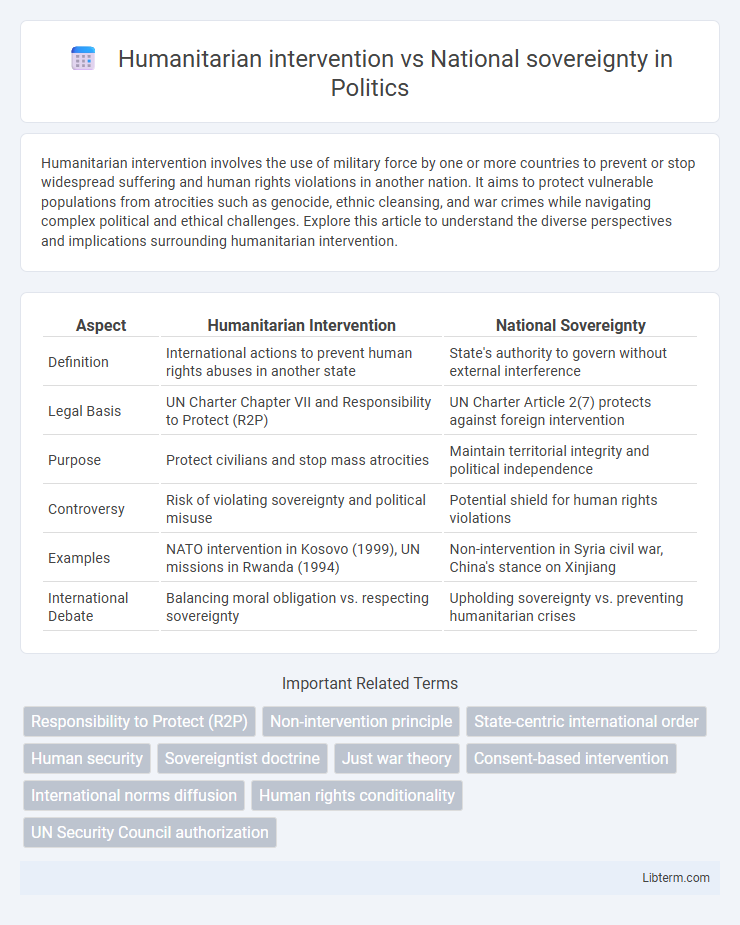Humanitarian intervention involves the use of military force by one or more countries to prevent or stop widespread suffering and human rights violations in another nation. It aims to protect vulnerable populations from atrocities such as genocide, ethnic cleansing, and war crimes while navigating complex political and ethical challenges. Explore this article to understand the diverse perspectives and implications surrounding humanitarian intervention.
Table of Comparison
| Aspect | Humanitarian Intervention | National Sovereignty |
|---|---|---|
| Definition | International actions to prevent human rights abuses in another state | State's authority to govern without external interference |
| Legal Basis | UN Charter Chapter VII and Responsibility to Protect (R2P) | UN Charter Article 2(7) protects against foreign intervention |
| Purpose | Protect civilians and stop mass atrocities | Maintain territorial integrity and political independence |
| Controversy | Risk of violating sovereignty and political misuse | Potential shield for human rights violations |
| Examples | NATO intervention in Kosovo (1999), UN missions in Rwanda (1994) | Non-intervention in Syria civil war, China's stance on Xinjiang |
| International Debate | Balancing moral obligation vs. respecting sovereignty | Upholding sovereignty vs. preventing humanitarian crises |
Understanding Humanitarian Intervention
Humanitarian intervention involves the use of military force by one or more countries to prevent or stop widespread human rights violations such as genocide, war crimes, or ethnic cleansing in another sovereign state. This practice challenges traditional notions of national sovereignty, which emphasize non-interference in a state's internal affairs. Understanding humanitarian intervention requires balancing the international community's responsibility to protect vulnerable populations against respecting the legitimacy and autonomy of sovereign nations.
Defining National Sovereignty
National sovereignty refers to a state's full right and power to govern itself without external interference, emphasizing control over its territory, laws, and policies. This principle is rooted in the Westphalian system, which establishes the legal equality and independence of states within the international community. Defining national sovereignty is crucial in debates on humanitarian intervention, as it often conflicts with efforts to protect human rights beyond borders.
Historical Context of Humanitarian Intervention
Humanitarian intervention has evolved significantly since the 19th century, with landmark instances such as the 1830 Belgian Revolution and the 1999 NATO intervention in Kosovo shaping its legal and ethical frameworks. Historical cases reveal a tension between the international community's responsibility to prevent mass atrocities and state sovereignty, codified by principles enshrined in the UN Charter. The development of the Responsibility to Protect (R2P) doctrine in the early 21st century reflects this ongoing debate, emphasizing state accountability while challenging traditional notions of absolute national sovereignty.
Key Principles of National Sovereignty
National sovereignty is grounded in key principles such as territorial integrity, political independence, and non-intervention by external actors, ensuring a state's authority over its own affairs and borders. These principles serve as a legal and ethical framework that prioritizes the self-determination of peoples and respect for existing governments, even amid global calls for humanitarian intervention. Balancing respect for sovereignty with the responsibility to protect populations from gross human rights violations remains a complex and debated challenge in international law.
Legal Frameworks: International Law and Intervention
International law establishes a complex legal framework balancing humanitarian intervention and national sovereignty, primarily through the United Nations Charter, which prohibits the use of force except in cases of self-defense or Security Council authorization. The Responsibility to Protect (R2P) doctrine further refines intervention criteria, emphasizing state obligations to prevent mass atrocities while respecting sovereignty. Legal debates persist regarding the legitimacy of unilateral interventions without Security Council approval, highlighting tensions between protecting human rights and maintaining state sovereignty.
Case Studies: Successes and Failures
Humanitarian intervention often challenges national sovereignty, as seen in successful cases like NATO's 1999 intervention in Kosovo, which prevented ethnic cleansing, while failures such as the 2011 intervention in Libya led to prolonged instability. The Rwandan Genocide of 1994 highlights a failure of intervention due to delayed international response, emphasizing the complexity in balancing human rights enforcement with respect for state sovereignty. Case studies reveal that successful humanitarian interventions require clear mandates, regional support, and post-conflict planning to respect sovereignty while protecting vulnerable populations.
Ethical Dilemmas and Moral Responsibility
Humanitarian intervention often clashes with national sovereignty, raising ethical dilemmas about the legitimacy of violating state boundaries to prevent human rights abuses. The moral responsibility to protect vulnerable populations challenges the principle of non-interference, questioning whether the international community should prioritize human welfare over political autonomy. Balancing respect for sovereign rights with the urgent need to halt atrocities remains a contentious debate in international law and ethics.
The Role of the United Nations
The United Nations plays a pivotal role in balancing humanitarian intervention and national sovereignty by authorizing actions through the Security Council to protect civilians from mass atrocities while respecting state sovereignty principles. UN peacekeeping missions and resolutions provide a legal framework for intervention, emphasizing international law and the Responsibility to Protect (R2P) doctrine. This framework aims to prevent abuses such as genocide and war crimes without undermining the foundational norm of non-interference in domestic affairs.
Challenges and Criticisms of Humanitarian Intervention
Humanitarian intervention often faces challenges related to the violation of national sovereignty, as states prioritize territorial integrity and political independence under international law. Critics highlight inconsistent application and potential for abuse, where powerful nations may exploit humanitarian motives to pursue strategic interests, undermining global trust. The lack of clear authorization and the risk of escalating conflicts further complicate interventions, raising ethical and legal dilemmas in balancing human rights protection with respect for sovereign governance.
Balancing Human Rights and State Sovereignty
Balancing human rights and state sovereignty involves respecting national sovereignty while addressing egregious human rights violations through humanitarian intervention. Effective intervention requires adherence to international law frameworks, such as the Responsibility to Protect (R2P), which legitimizes action when states fail to protect their populations from genocide, war crimes, or crimes against humanity. The challenge lies in enforcing accountability without undermining sovereign governance, maintaining global stability and ethical responsibility.
Humanitarian intervention Infographic

 libterm.com
libterm.com